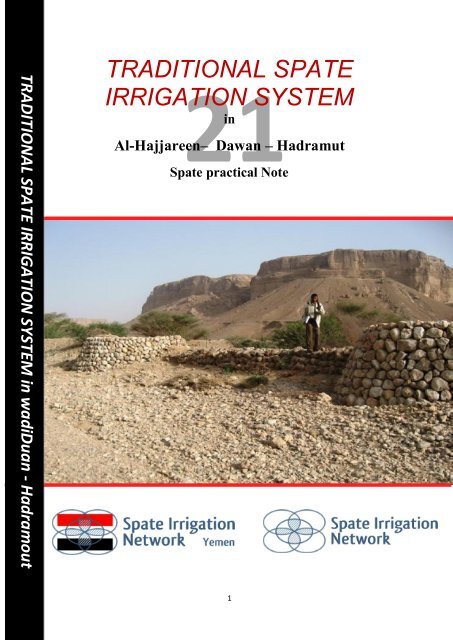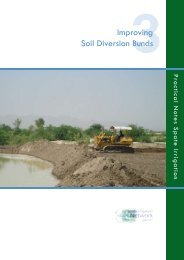English - Spate Irrigation Network
English - Spate Irrigation Network
English - Spate Irrigation Network
You also want an ePaper? Increase the reach of your titles
YUMPU automatically turns print PDFs into web optimized ePapers that Google loves.
TRADITIONAL SPATE IRRIGATION SYSTEM in wadiDuan - HadramoutTRADITIONAL SPATEIRRIGATION21SYSTEMinAl-Hajjareen– Dawan – Hadramut<strong>Spate</strong> practical NoteImprovement and Soil Moisture Conservation in <strong>Spate</strong> <strong>Irrigation</strong>1
<strong>Spate</strong> prac cal Note 211. IntroductionGeneralTraditional structures of <strong>Spate</strong> irrigation are old-style forms of water resources management.They areused in arid and semi-arid regions. Examples can be found in Alghber - Alhajareen valley which is abranch from Doan Valley and islocated withinwadiHadramout, Yemen. Traditional structures areestablished to take advantage of spate water wisely and economically by using gravity. <strong>Irrigation</strong> practiceinvolves the diversion of hasty spate floods running off from plateaus catchments. . Although it usuallyflows few hours with appreciable discharge, it has recession flows lasting for a few days.<strong>Spate</strong> irrigation with traditional structures has several benefits. They manage spate flow for cropproduction, rangeland, local agroforestry, water ponds for livestock and aquifer recharge. The main cropcultivated in spate irrigation areas is sorghum,Crops are irrigated once or twice per season.Moreover,crops gets residual moisture stored in the deep alluvial soils from the sediments deposited in previousirrigation.LocationAl-Hajjareen is a tributary area of Doan directorate that is situated within the downstream of Doanvalley. Its centre Coordinate is 39 P E 214224 N 1714018. Doan is one of 30 directorates inHadramawtgovernorate within Eastern plateau in Yemen. It is located in south-west of Sieyaun city,capital of province, about 100 Km (Asphalt) distance and 800 Kmdistance of Sana'a (capital city).On theother hand, Doan valley is a tributary of wadiHadramawt. Seefis a capital city of Doandirectorate(Figure 1).Figure (1):Geographic regions [6].TopographyAlhajjareen area is a part of Hadramout's plateau which lies about 1,000 meters above sea level. Thisplateau was being crossed by huge valleys (wadis) which were being made by gigantic floods in thepast. Valleys' waterbeds are about between 700-800 meter above sea level. Valleys' banks have semiintensesteeps. There are three waterbeds (valleys) called Doan(main), Algabar and Algawo(branches).2
GeologyThe HadramoutWadiis formed by tertiary's formations.It has four geological layers group butits canyons are covered with Quaternary depositsFigure (2).WadiHadramout is located in acanyon that is cut through the carbonate rocks of the Hadramawt Group. The vertical sides ofthe canyon rise 300 m above the top of the Quaternary deposits. The aquifer areapproximately90 km long, 1.5 to 20 km wide and locally more than 100 m thick. It has hightransmissivityand good sources of rechargeFigure (2). Various large tributaries quickly bringfloods from around 22500 km2 over the limestone plateaus to WadiHadramawt canyon [6].TRADITIONAL SPATE IRRIGATION SYSTEM in wadiDuan - HadramoutClimateFigure 2:Schematic geological cross-section through WadiHadramawt[6]The climate is hyper-arid. It is hot throughout the year with maximum temperaturesranging from 38 °C to 45 °C in summer. Climate data from 1986to2005,(Figure3)shows:a humidityrate of 34%, Avg. Max temp.of 36 °C, Avg.Min temp. of 17.5 °C,dailyevaporation of7.5 mm, daily rainfallof 5.8 mm and annually rain fall of about50mm.HydrologyEvery seasonthe spatesflow through the valleys(wadibeds). Even in dry years ofscarcity floods,it has floods flow at least twice. The area has annually two rainyseasons: first during March-April, second during July-August.From south to north Al-Hajjareen surface water flows into Arabian Sea Basin.Thenitswater assembles with wadi Al-Ain and wadiAmed to put their water in wadi Al-Masellah(Figure 1).3
<strong>Spate</strong> prac cal Note 21Figure 3:Rate of climate data between1986-20052. Traditional irrigation structures in wadiHadramoutAccording to Al-Hajjareen residents the traditional irrigation system in Al-Hajjareenexists since many hundredyears. This system was founded by an oldcivilization that were called Kindah.They were dwelled in the area and dependingon spate irrigation. Farmers deducted quantities of spate water from upstream areas bybarriers (Aldhameer). The barriers diverted the spate water through main canals,which werebuilt by farmers to convey the flood water under gravityover their lands.Farmers in Al-Hajjareeen area still teach their sons the traditional irrigation ways,such as building irrigation structures that helps to control spate water and protect theirlands and canals from erosion. However, the new generation has been using modernequipment. They have an apatheticattitude formanagingtheir land in comparison withtheir ancestors.<strong>Irrigation</strong> <strong>Network</strong><strong>Spate</strong> irrigation networks in Al-Hajjareen area consist of more than 10 main canalsthat supply agricultural fields with spate water. Every canal diverts spate irrigationwater from spate stream (wadi) by masonry or earthy barrier (Aldhameer) whichareconstructedin the beginning of the canal. The bodies of all the canals are earthy,except parts of the beginnings of the main canal and where farmers controlwater(Figure 4).4
TRADITIONAL SPATE IRRIGATION SYSTEM in wadiDuan - HadramoutFigure 4:Layout of Al-Hajjareen Agricultural scheme3. Traditional spate irrigation structures in Alhagareen Area:There is several irrigation structure are used in Alhagareen area, these structures are mentioned as follows:1-Aldhameer (barrier):Itis a spur-like diversion structure made from stones and rock,which farmers have been burying withspatebed deposits in shape of long piles, in order to be firm. The structures have a deep base thatextends at an obtuse angle from the 'ras al-sygiyah' (the canal intake)to middleof wadi channel,usually against the direction of the floodwater flow in the wadi. The height of the spur graduallyincreases from ground level in the middle of valley to 1-1.5 meters at the canal intake. This gradualdifference in height is to avoid obstructing the water's passage, to avoid destroying Aldhameer, and tocontrol the incoming water flow(Image 1).At the down-stream of valley where it widens out into the agricultural land and the flowspreads out, the valley needs to be closed off completely. Therefore Al-dhamer were constructedacross the wadi channel to divert flood water to the maincanals. Also the wadi branches are closedoff by Aldhameer because they have a small catchment area and flood flow[5&8]..Image (1- A): Aldhameer (barrier)5Image (1- B) :Aldhameer(barrier)
<strong>Spate</strong> prac cal Note 212-Saqiyyat Aldhameer (main canal)The main body of the Saqyyah is made up of two walls . The outside one is facing the valleyand an inside one facing agricultural land(Image 2). It contains openings to divert water tonearby agricultural lands called Almarab (farm's canal); however, this canal continues until itends atAlatheed (canals divider). This canal has an overflow structure, built after 100metersfromAldhameer on outside wall of Saqyya. It calls MankiSaqiyyatAldhameer(Almansam) (spillway) .The Manki or Mansam is constructed beside the canal intake tocontrol overflow water to be back to the wadi.Image (2 –A): SaqiyyatAldhameer (main canal)Image (2 –B): SaqiyyatAldhameer (main canal3-Manki SaqiyyatAldhameer (Almansam)MankiSaqiyyatAldhameer (Almansam) is a structure which exists through the first 100 metersof saqyyatAldhameer on outerside wall. This structure is about 10 to 15 meters long depressionin the height of the saqyyatAldhameer wall facing the wadi spatebed ((Image 3)and (figure5)). The Mankistructures is used to control the excess water (overflow) diverted to theirrigation canal.Itbrings this excess water back to the wadi.The Saqiyaah takes only its safespate water capacity[5&8].Image (3): MankiSaqiyyatAldhameer(Almansam)Figure (5): MankiSaqiyyatAldhameer(Almansam)4. Alrasah (stony wall)This structure is a stony wall with mortar substance(Image 4). Its back usually faces thespate flood channel side and protects the canal from erosion. It exists after the intakes ofthemain canal (after Aldhameer where the flow is still disturbed).6
Image (4): stony wall which calls Alrasah5. Alatheed (canals divider)This structure is a stony wall which divides the main canal into two canals or more bymany dividers (Atheeds).Each divider goes to different directions, and each canal hasdifferent bed levels, which depends on the irrigated fields distance from the maincanal(Image 5).TRADITIONAL SPATE IRRIGATION SYSTEM in wadiDuan - HadramoutImage (5-A):Alatheed (canals divider)7Image (5-B):Alatheed (canals divider)6. Almarab (farm's canal):It is a small canal that extends between farm and canals system (farm off-take) Itirrigates the land under a certain slope which takes into account the location and size ofthe irrigated area.. Palm's Marab is the deepest and will get much water.It has a Harah(door). Its maintenance depends on the farm owner himself, so it is out of Alkhyel'srecommends. Alkhyel only watches its dimensions(Image 6).Image (6 A&B): Almarab (farm's canal)
<strong>Spate</strong> prac cal Note 217. Alharah and its shapes:It controls the quantity of water under aspect of quantity and prevents the driftage.Shape in Image (7-A&B).it conveys and controls the water flow from one canal tomulti-level canals under aspects of quantity spate. It also prevents the driftage in steepcanals.Image 7-(A&B)Alharah,to prevent the driftage8. Fields’ Manki: (surplus outlet)These structures control the irrigated water level in the field and field erosion, so ithelps canals to get rid of surplus water back to wadibed or to the next low field. Thisstructure is constructed from dry stones or stones with lime or cement mortar (it linesby stones) to protect land soil erosion from higher field to lower field(Image 8).Image (8-A&B): farm's Manki9. The operation and maintenance practices in wadiDuanAccording to the farmers, eachfarmer must maintain the branched canal near his farmas Alkhyel (canal supervisor) recommended him. While the main canal takes itsenough maintenance by modern equipment, tractor, or loader that finances by Alkhyelfrom fines, givers, and shares. Following traditional rules and practices, Alkhyelorders farmers to maintain their farm canals and to pay for the maintenance of maincanal.Alsond customs but Alkhyel push them to organize the times and shifts forirrigation system, which helps farmers in spate water distribution and canalsmaintenance. The small saqiyya (Almarab), which convey water to farm, should becleaned by the farmer(Image9). Sometimes main canals are damaged, thenAlkhyelcollects money from immigrant donors (charities) and repair canals by build stonywalls (Image 10)or rent tractors (Image 11)to repair Aldhameer and any damage inmain canals.8
Image (9): maintain canals by building stony wallsImage (10): maintain canals by rent tractors or loaderTRADITIONAL SPATE IRRIGATION SYSTEM in wadiDuan - HadramoutImage (11): maintain farm's canal (Almarab) by farm's owner10. Conclusion:Traditional spate irrigation system in Alhajareen consistsof more than ten main canalswhich supply spate water to agricultural fields. In general, every agricultural fields hasspate irrigation structures start from high level with two important units.First:the main units which consistdiversion structure (Aldhameer), after that the maincanal (SaqiyyatAldhameer), then the canals dividers (Alatheed), then the branchedcanals, then the farms canal (Almarab).Second: control units; overflow's structure (Almansam or Almanka) in first100mm ofmain canal, stony wall (Alrasah) in one third of the main canal, Alharah and its shapesin branched canals, overflow openings ( Al-Mankaa) in the end of canals or betweenfarms.System in Alhajareen is controlled by inherited traditions and customs, which allfarmers know. Farmers must maintain branched canal near their farms as Alkhyelrecommended them. Main canal takes maintenance by modern equipment, tractor orloader which is financed by Alkhyel from fines, givers, and shares.The traditional spate irrigation system inAlhajareen faces big damage problems andsediments as in Damoon and Khedoon. All this system in the area need rehabilitationfor agricultural lands and spate structures.Farmers need awareness about the importance and maintenance of consecrated landstoface future food needs.9
<strong>Spate</strong> prac cal Note 2111. References:[1] UNDP & FAO. "spate irrigation" ,proceedings of the subregional expert consultation on wadidevelopment for agriculture in natural Yemen , working papers, 6-10 December,1978.[2]Alawi, Abdullah, and Omar. Integrated spate irrigation management in Alhajareen- Doan-Hadramut. Master diploma Case study. Yemen. 2012[3]Jonathan Tsoka. "Optimisation of the design of diversion structures in a spate irrigation scheme",Case study of Gash Agricultural Scheme in Sudan, UNESCO-IHE institute for water education. MScThesis WSE-HE-LWD, ,April 2012[4] Na onal DataCenter “ accoun ng of popula ons houses and structures of 2004”. Annual sta caccount year 2004.[5]Eng. Salem Baquhaizel,others. "Documentary study on models of Traditional irrigation systems& methods of water harvesting in Hadramout and Shabwahgov". WEC, META, etc. report 1996 andbook 2010.[6]Lectures of IWRM master which we have studied in Water and Env. Centre – Sana'a Uni. 2010-2011.[7]NWRAagricultural department Sayaun branch “collected data from Agr. , water, &Env.institutions of wadiHadramout , 2010 t0 2012.[8]Collected data from field.ColofonThis note is prepared by Eng. Alawi Mohsen Abdul Moghni,Eng. Abdullah Mohammed Al-Saidi,And Eng.Omar Bin-Shehab (two diploma students in WEC).The <strong>Spate</strong> <strong>Irrigation</strong> <strong>Network</strong> supports and promotes appropriate programmes and policies in spateirrigation, exchanges information on the improvement of livelihoods through a range ofinterventions, assists in educational development and supports in the implementation and start-up ofprojects in spate irrigation.For more information: www.spate-irrigation.org.Reviewed and published by:Dr.SharafaddinA.A.Saleh (WEC - Sana'a University – Yemen)10








